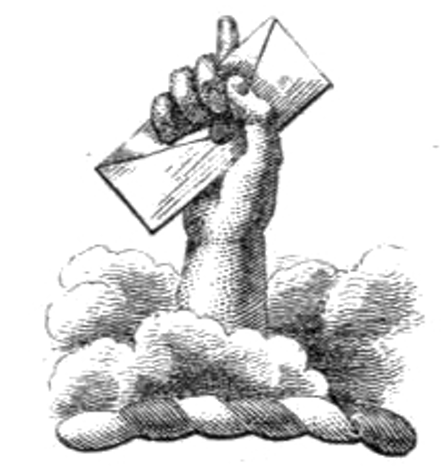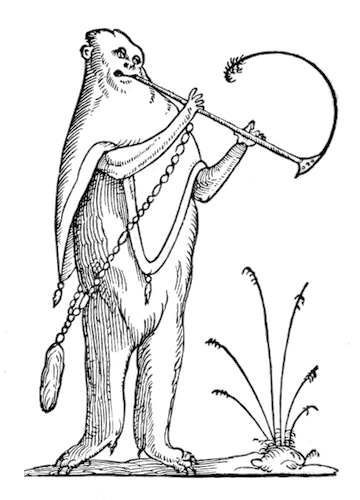
Jack London, Jack Johnson, and the Fight of the Century
Held in Jim Crow–era Nevada on the 4th of July, the 1910 World Heavyweight Championship was slated to be a fight to remember. Moonlighting as a boxing journalist, novelist Jack London cheered on Jim Jeffries — ringside and on the page — as the “Great White Hope", a contender to take back the title from Jack Johnson, the first Black heavyweight champion. Andrew Rihn examines the contradictions of London’s racial rhetoric, which is more complex and convoluted than it may initially appear.
March 26, 2025
“Jeffries Knock-Out”, photograph of the Jack Johnson vs. Jim Jeffries during the World Heavyweight Championship of 1910 — Source.
“Ask people who know me today, what I am”, Jack London wrote in a 1903 letter to Charmian Kittredge, who would become his second wife. He provided his own answer: “A rough, savage fellow, they will say, who likes prizefights and brutalities, who has a clever turn of pen.”1
Today, the American author and adventurer is best remembered for his Klondike stories The Call of the Wild (1903), White Fang (1906), and To Build a Fire (1908). London is less remembered for his war reporting in Korea and Mexico, his staunch socialist politics, and lesser still for his adventures beyond the Yukon, including several years spent sailing and writing about the Pacific. And as a boxing writer? His reputation in that regard has been almost completely lost to history.
London was an avid fan of prizefighting. He learned to box as a young man in the 1890s, taking lessons from Herman “Jim” Whitaker, a fellow writer and socialist who had previously taught boxing while in the British Army.2 Throughout his life, London would spar and scrap with friends, acquaintances, houseguests, and even the occasional world champion. He counted Bob Fitzsimmons, “The Fighting Blacksmith”, among his friends, even once writing a small vaudeville scene for Fitzsimmons and his wife to perform.3
1904 photograph of Jack London posing as a boxer — Source.
Boxing at that time had only recently been “civilized” through the adoption of the Marquess of Queensberry rules, which standardized the time of rounds, outlawed wrestling, and required gloves. At the turn of the century, the sport was only quasi-legal in the United States. Prize fights were often held clandestinely, avoiding the authorities by restricting knowledge of the match’s location and time to those of the “fancy”. Or fight organizers skirted the law by holding “athletic exhibitions” instead of “prize fights” in “private” saloons and taverns, which anyone could join for a small fee.
While the poet Walt Whitman had sung pugilism’s praises anonymously in his recently recovered “Manly Health and Training”, Jack London was the first major American writer to give the sweet science sustained literary attention.4 Preceding Ernest Hemingway by more than a decade, he followed European novelists’ treatment of the sport, including George Bernard Shaw’s Cashel Byron’s Profession (1882) and Arthur Conan Doyle’s Rodney Stone (1896). London wrote four works of boxing fiction — two short stories and two short novels. But where he really scored a knockout was in reporting on fights for the newspapers.
Although London covered a number of prizefights, it is his reportage on the Jack Johnson vs. Jim Jeffries fight of 1910 that is most often remembered. Johnson-Jeffries was a huge event. It was the first fight to be declared the “Fight of the Century” and resulted in riots, murder, and changes to federal law. London’s coverage of the fight was substantial, and his use of racialized and racist tropes was conspicuous. While such language rightly draws the attention and ire of modern readers, its shock value can lead some to frame (or even dismiss) London’s boxing coverage as solely racist propaganda (as was the case in the Ken Burns’ 2005 documentary Unforgivable Blackness). A deeper look at London’s boxing coverage, however, reveals a more nuanced, sometimes contradictory, approach to race. The foundations of some of the racialized themes London used in describing Johnson vs. Jeffries can first be seen (and better understood) in his earlier boxing writing.
Promotional flyer from the San Francisco Chronicle advertising the World Heavyweight Championship fight of 1910 — Source.
In 1901, London covered the heavyweight contest between James “Jim” Jeffries and Gus Ruhlin for the San Francisco Examiner. His article “Gladiators of Machine Age” demonstrates London’s love of the sport, and shows him to be a man who has spent considerable time not only writing about boxing but thinking about it — and enjoying it as well.5 He opens the article by describing Jeffries and Ruhlin — both white — this way: “A big, dark male, hairy of chest and body, in one corner; in the other corner a big, light male, smooth of skin and serious of face.” Jeffries (the “dark male”) beat Ruhlin (the “light male”), and London mourns the defeat with the claim that Ruhlin was not “animal” nor “elemental” enough. “When all is said and done”, London writes, “the prize fighter, big-muscled and brutish and barbarous is a finer thing than a decadent.”
In 1905, he reported on the fight between Jimmy Britt and Battling Nelson in “Brain Beaten by Brute Force”.6 As he did with Jeffries and Ruhlin, he writes of this fight between two white fighters with terms that he would also employ for racialized effect in his coverage of non-white fighters, referring to them both as animals. He offers the distinction that Britt is an “intelligent animal” while Nelson is a “fighting animal”. London also coins a phrase he would reuse many times in his writing: the fighter as “abysmal brute”. He clarifies for the reader: “I do not wish to call Nelson a brute; but what I wish to say is that Nelson possesses to an unusual degree the brute that you and I and all of us possess in varying degrees.” It is this brutish nature, a “Berserker rage”, that wins Nelson the fight. (London would go on to deploy the term in more than just his nonfiction: it became the title of a short novel, again in reference to a white fighter, published in 1913.)
Illustration from the first Canadian edition of Jack London’s The Abysmal Brute (1913) — Source.
In 1908, illness cut short an ambitious sailing trip and London found himself in Australia seeking some R & R.7 In Sydney, he covered the contest between Jack Johnson and Tommy Burns for the world heavyweight championship. Johnson was a fearsome Black contender from Galveston, Texas. Avoided by many of the best white fighters of his time, he held the World Colored Heavyweight title. The World Championship title was held by Tommy Burns, a white fighter and to this day, the only Canadian-born heavyweight champion of the world. Johnson pursued the globe-trotting Burns, agitating for his shot at the title. When that chance finally came in Australia, “The Galveston Giant” made easy work of Burns, and London described the fight in the pages of The San Francisco Call.8 “A golden smile tells the story”, he wrote, referring to Johnson’s gold teeth, “and that golden smile was Johnson’s.” He was unequivocal about Johnson’s success: “There was no fraction of a second in all fourteen rounds that could be called for Burns”. Throughout the article, London refers to Johnson as “Ethiopian” but also as a “colossus”. Burns is portrayed as a “futile white man” and compared to a “naughty child” being punished. Unlike his earlier articles, which relied heavily on London’s racialist thinking to form the backbone of their argument, London’s description of the Burns-Johnson fight surprisingly lacks such commentary.
This absence was actually the work of American newspaper editors who cut down a longer version London wrote for the Australian press. The difference between these two versions is striking. In The Australian Star, London had fleshed out some of his complicated feelings about race.9 “Personally I was with Burns all the way”, he confesses. “He is a white man, and so am I. Naturally I wanted to see the white man win.” London continues: “There is no foolish sentimental need to gloss over Burns’s defeat. Because a white man wishes a white man to win, this should not prevent him from giving absolute credit to the best man who did win, even when that best man was black. All hail to Johnson. His victory was unqualified.” The frankness with which London states his sentiments here is unusual, even jarring to modern readers more accustomed to duplicitous euphemisms and dog-whistle rhetoric.
London closed his article with an unexpected and partisan appeal. In the pages of The San Francisco Call, he spoke directly to former heavyweight champion (and white man) Jim “Boilermaker” Jeffries. London implored Jeffries’ to come out of retirement with these infamous lines: “But one thing remains, Jeffries must emerge from his alfalfa farm and remove that smile from Johnson’s face. Jeff, it’s up to you.”
Jeff, It’s Up to You.
With that simple phrase, London bound his legacy forever to boxing’s perennial expression of white resentment, the near-mythic desire for a “Great White Hope”. Although Jack Johnson was not the first Black boxing champion (that accolade goes to George “Little Chocolate” Dixon, who grabbed the bantamweight title in 1888), Johnson was the first Black heavyweight champion, making him the most well-known, both famous and infamous.
Promotional flyers advertising the World Heavyweight Championship fight of 1910 — Source.
Johnson lived his life unapologetically. He dressed in fine clothes, played the bass viol, and drove expensive cars. Most controversially in the Jim Crow era, he publicly dated a number of white women. While many writers, often more vitriolically than London, tried to limit him with racial stereotypes, Johnson exceeded their narrow categorization at every turn. When his detractors could not stop him through denigration, they changed tactics and sought a white fighter to end Johnson’s championship run. And later, when even that didn’t work, the government stepped in with trumped up allegations, charging him with violation of the Mann Act in 1912. Johnson fled and spent seven years in exile. Upon his return to the United States in 1920, he served one year at the Leavenworth Penitentiary in Kansas. Exile and prison robbed Johnson’s career of its momentum, and the former champ was forced to appear on stage and in the ring to make ends meet. He died in 1946, having crashed his car after being refused service in a segregated diner. In the decades since, his legacy has grown immensely and Jack Johnson is widely considered one of the greatest heavyweight champions of all time.
Jack Johnson at the wheel of his 90 horsepower Thomas Flyer, 1910 — Source.
Photograph of Jack Johnson with his manager George Little, ca. 1900 — Source.
Jeffries did eventually agree to emerge from his Burbank alfalfa farm to face Johnson. In 1910, London was back in the United States and provided copious pre-fight commentary, about a dozen articles in all, each covering a different aspect of the upcoming contest. In one, he described the men separately; in another, he described them in tandem. He dissected their ring tactics, analyzed their character, and estimated their “abysmal brutishness”.10 London’s racialized discourse is at times bewilderingly inconsistent, contradictory, and sometimes downright bizarre. He wrote, for instance, about “protoplasmic vigor”11 and the effects of “cell generation”.12 London did not forget the one-sided beating he had witnessed in Sydney, yet through some racist gymnastics, he portrayed Johnson’s talent as a liability. Johnson was more “boxer” than fighter: too smart, too stylized, and even too affable a person to remain champion. In the pages of the The Spokesman-Review, London harks back to The Call of the Wild, portraying Jeffries as “still red of fang and claw”, more “Germanic tribesman and warrior” than civilized, modern man.13 London has reversed the usual racial stereotypes of savagery and civilization, and yet Johnson still comes out the worse for it.
In The Montreal Star, under the nondescript title “Jack London Gives Views on Fighting”, he penned what reads as a heartfelt and eloquent love letter to the sport he so identified with.14 He praises boxing for its application of “ethical nature” and “fair play”, which he views as an important step-up from “jungle fighting”. “Some day”, he writes, “the ape and tiger in us will completely die out”, and sports will look quite different. Here, as with the notion of the “abysmal brute”, London writes of a universal atavism that “you and I and all of us possess in varying degrees.”15 Returning to a general history of boxing, London’s racialist interpretation also returns, declaring that the sport “belongs unequivocally to the English-speaking race”.16 He continues: “It is as deep as our consciousness, and is woven into the fibers of our being. It grew as our very language grew. It is an instructive passion of race. And as men to-day thrill to short Saxon words, just so do they thrill to the thud of blows of a prize fight.”
 Scroll through the whole page to download all images before printing.
Scroll through the whole page to download all images before printing.“A Sure Bet — J. J. Will Win”, 1910 promotional postcard for the World Heavyweight Championship fight — Source.
 Scroll through the whole page to download all images before printing.
Scroll through the whole page to download all images before printing.“Jeffries-Johnson Records”, promotional booklet produced in the lead up to the World Heavyweight Championship fight of 1910 — Source.
As the day drew nearer to the “Fight of the Century”, he began to describe the two men in increasingly equal terms. “Johnson, the fighting boxer, will go up against Jeffries, the boxing fighter.”17 He declared that no one in the history of the ring could equal these two “giants”, and that “in their own generation there is no third man who approaches them”. For all his enthusiasm, he could not fully shake free of his racialist language, adding that “it has taken not only a generation, but two races to produce them.”
Just days before the fight, London was excited. He wrote: “I am so keenly interested, so overwhelmingly desirous of witnessing this contest, that there are moments when sudden fears assail me, such as that the fight will not come off, that it may be prevented by some great earthquake or terrific cataclysm of Nature. Why, I want to see that fight so bad that it hurts.”18
The fight took place in Reno, Nevada, on Independence Day, July 4th, 1910. After all the hype and hyperbole, it ended up being more fizzle than firework. Johnson cruised to a technical knockout in the 15th (of a brutally scheduled 45 rounds), when Jeffries’ corner stepped in to stop the fight, so as to spare their previously undefeated man the blemish of a knockout on his record. “Little Tommy Burns down in far-off Australia put up a faster, quicker, livelier battle than did Jeff”, wrote London.19 “The fight today, and again I repeat, was great only in its significance. In itself it was not great.” As with the Burns fight, London describes Johnson as having never been “extended” during the fight, again downplaying his dominance as merely “playing” with the opponent.
Admission ticket for the Johnson-Jeffries fight, 1910 — Source.
The Crowd at the Ringside. Reno, July 4, postcard of the Johnson-Jeffries fight by San Francisco’s Dana Photo, 1910 — Source.
Photograph of the Johnson-Jeffries fight by San Francisco’s Dana Photo studio, 1910 — Source.
Photograph of the 9th round of the Johnson-Jeffries fight by San Francisco’s Dana Photo studio, 1910 — Source.
Despite his prejudices, London offers words of propitiation after the fight. He has high praise for both Johnson’s ring fighting and “mouth fighting”, dubbing him the “king of fighters and monologists”.20 London even goes out of his way to stall complaints that Jeffries was simply past his prime: “it is to be doubted if the old Jeff could have put away this amazing negro from Texas”. And he ends the piece wryly, with a self-recriminating jab at his earlier call for a Great White Hope: “And where now is the champion who will make Johnson extend himself, who will glaze those bright eyes, remove that smile and silence that golden repartee?” It’s a concession speech of sorts. Johnson had defeated Tommy Burns and Jim Jeffries in the ring. And by dashing the Great White Hope that London yoked his reputation to, Johnson managed to defeat the writer as well.
“To me it was not a racial triumph”, wrote Johnson years later in his memoir In the Ring and Out (1927), “but there were those who were to take this view of the situation, and almost immediately a great hue and cry went up because a colored man was holding the championship.”21 Johnson held the championship for seven long years. In all that time, he faced only white opponents. Johnson’s motivation was financial; he could earn more money fighting an unknown white opponent than he could facing the toughest Black opponent. The result was that Johnson effectively redrew the “color line”, the practice of the champion refusing challenges from Black contenders, that had stymied his own competing title shot just a few years prior. Greats such as Sam Langford, Sam McVea, Joe Jeannette, and Harry Willis were all denied title shots by Johnson (even though Johnson had been happy to face Langford, McVea, and Jeannette before becoming champion). Johnson eventually lost the title in 1915 to Jess Willard, a white fighter known as “The Pottawatomie Giant”, who stood six feet six inches but possessed little true fistic talent. The fight went a grueling twenty-six rounds under a blistering Havana sun and ended with an exhausted Johnson flat on his back against the canvas. Jack London was not there to cover the match.
Postcard of the 1915 Johnson-Willard fight, with an inscription reading: “‘The Count’ that made Jess Willard the Cowboy Champion of the World”, ca. 1915 — Source.
In her book Jack London’s Racial Lives, Jeanne Campbell Reesman notes that “in any twenty-first century usage of the word, London would certainly be termed a racist.”22 And, she goes on to say, he is “not a very good (that is, consistent) one.” In both the Burns and Jeffries fights, London begins his coverage by siding with the white fighters “all the way”. But in both cases, he ends up offering unequivocal praise of Johnson. She also notes that genre appeared to play a role in London’s critical view of race. While he had a penchant for racialism and outright racism in his nonfiction, London demonstrated a more open-minded approach to race in his fiction, especially in the Pacific short stories. London “could not merely stay with one point of view, especially when it came to race”, Reesman concludes.23
It bears noting that similar coverage at the time contained far worse than London ever wrote, screeds bursting with racial slurs and invective that were practically advertisements for an imminent race war. Indeed, in the aftermath of Johnson’s emphatic defeat of Jeffries, many whites rioted across the United States, assaulting hundreds and lynching dozens of Black people. Cities and states sought to ban showings of the fight film, and the federal government responded by outlawing interstate travel of fight films, a ban which remained in effect until 1940.24
The racial contradictions that went unresolved in London’s boxing coverage haunt us with their familiarity. His work, in this regard, resonates with a sad relevance. The idea of the “Great White Hope” resurfaced across the twentieth century virtually any time a Black fighter won the championship, most notably with Jerry Quarry (against Muhammad Ali) and Gerry Cooney (against Larry Holmes). Even today, boxing commentary remains plagued by racialized and racist discourse, not only by the usual anonymous suspects online, but even by writers for the prestigious Ring magazine.
As Norman Mailer is linked to Muhammad Ali, and Joyce Carol Oates to Mike Tyson, so is Jack London’s legacy in boxing letters linked to Jack Johnson. These two men were among the biggest celebrities of their time, a pair of wild Jacks who exceeded the purlieus of their given professional domains. Their connection highlights the racialist aspect of London’s boxing coverage. London is certainly no icon for anti-racism, but neither was he the diehard, simple-minded racist he is sometimes suggested to be. His views on race were undefined, contradictory, and liable to shift with the slightest breeze. Though his prejudices are repugnant, he did not let those prejudices get in the way of recognizing the better fighter when the fight was over.
London died in 1916, only forty years old, of complications related to an untreated kidney disease. In the century since his death, his legacy has been pared down to a couple of Yukon stories, and those are often dismissed as mere adventure literature for middle school boys. In 1910, Jack London was already famous for his fiction, and he lent his celebrity to a fledgling sport looking to gain legitimacy in the American mainstream. In doing so, he blazed a path in boxing which numerous novelists (including Hemingway, Baldwin, Mailer, and Oates) would follow. He produced unique and provocative reportage, yet through his own doing, he is forever yoked to the ugly inheritance of the “Great White Hope”.
Andrew Rihn is the author of Revelation: An Apocalypse in Fifty-Eight Fights (Press 53, 2020), a prose poem collection about Mike Tyson, and a forthcoming collection of retro pulp stories based on the work of Robert E. Howard. He is a regular contributor to a number of boxing websites. Andrew lives in Massachusetts.
Enjoyed this piece? We need your help to keep publishing.
The PDR is a non-profit project kept alive by reader donations – no ads, no paywalls, just the generosity of our community. It’s a really exciting model, but we need your help to keep it thriving. Visit our support page to become a Friend and receive our themed postcard packs. Or give a one-off donation. Already a supporter? A huge thank you for making all this possible.




















